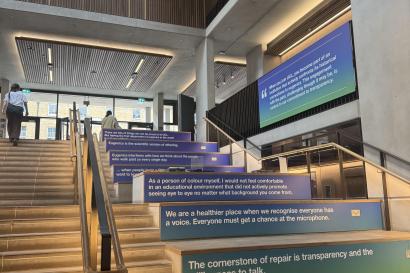Breakfast
One of the earliest and most depressing realizations that I had during study abroad was that breakfast in the United States is seriously underappreciated. Pancakes, eggs, bacon, bagels—these are all things that I took for granted before I arrived in Buenos Aires. Rather than large meals in the mornings, Argentines prefer to start their days with light snacks. My host family’s normal breakfast consists of coffee and some type of cracker or tostado (toasted bread) with jam, butter, or dulce de leche. Other typical breakfast foods include medialunas (pastries similar to croissants) or fruit.
Some of the best places to go for breakfast include bakeries or local neighborhood cafes, where you can get café con leche (coffee with milk) and medialunas cheaply.
Lunch
An advantage to living in the middle of a huge city is the sheer range of restaurant options at your fingertips. Because Buenos Aires is so westernized, you can find a huge variety of types of food—from sushi to asado—at many price points, many of them within walking distance from the IES Abroad Center. Some of the cheapest lunch options are take-out foods like empanadas, chorripan (sandwiches of bread and chorizo), or pizza. Another budget favorite are “comida por peso” Chinese restaurants, which offer a mix of Chinese, American, and Argentine buffet-style foods that you pay for by the kilogram. If you’d prefer to sit down and eat, most cafes offer reasonably priced sandwiches, salads, and specials.
Merienda
A merienda, similar to a mid-afternoon snack, occurs around 5 or 6pm and typically includes coffee and a pastry. The most popular coffee orders in Argentina are a little different than the non-fat, double shot, iced, upside down caramel macchiatos with soy milk and whip cream that I’ve heard people order in the United States. A café con leche is the most popular drink, which is half espresso and half milk. A cortado has about 75% espresso and 25% milk and the exact opposite, a lagrima, has about 75% milk and 25% coffee. Iced coffee is not popular with porteños, but if you’re addicted to it like I am, you can get your fix of iced lattes at western-style coffee shops or Starbucks during the warmer months (it was almost impossible to find iced coffee drinks during winter). Meriendas are important social activities in Argentina—drinking espresso in a café with friends is extremely popular—and can last between one and two hours.
Dinner
Argentines like to eat dinner late, usually between 8 and 10pm, so if you eat dinner early in the United States like I did, get ready for a big adjustment. Customary dinners in Argentina are similar to the United States—some form of protein like meat, chicken, or fish with seasonal vegetables, potatoes, or rice. High quality meat is relatively cheap in Argentina and therefore, extremely prominent—which makes asado or traditional barbequed meat extremely popular. Pasta dishes and pizza are also common because of the influence of the massive amounts of Italian immigrants to Argentina. One of the biggest complaints I’ve heard about Argentine food is how bland it is. Rather than the spicy foods stereotypically associated with Latin American cultures, Argentine cuisine is unexpectedly mild and bland so bring your own hot sauce if you think you're going to miss it. Popular after-dinner desserts include alfajores, flan, or fruit and cookies with dulce de leche.
A Note on Maté
The most prevalent drink in Buenos Aires (as well as many parts of Argentina and Uruguay) is maté, a strong, bitter tea served in traditional maté cups made from hollowed gourds, wood, or metal. Maté is drunken with a metal straw or bombilla that filters out the loose leaf tea, the yerba maté, that fills the cup. Maté is a social drink meant to be passed and shared between friends or groups of people, and therefore it is not typically served in restaurants or cafes. The best way to enjoy maté—and to learn the complicated etiquette that dictates how to drink the tea and what to say afterwards—is to share some with an Argentine local.

Maria Oldenburg
<p>I am Maria Oldenburg, and I'm a sophomore Economics and International Studies double major at Case Western Reserve University in Cleveland, Ohio. On campus, you can find me pretending to be a professional photographer, exploring the local coffee scene, or hopelessly planning my dream backpacking trip across Southeast Asia. Originally from Pittsburgh, Pennsylvania, I can't wait to eat my weight in empanadas, learn quality puns in Spanish, and tango with the best of them during my semester in Buenos Aires!</p>





